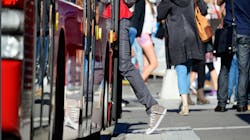From MTI: A fixed route, not fixed approach: Adapting fixed-route transit for optimal accessibility and equity in a pandemic
The Mineta Transportation Institute (MTI) has released its latest report that analyzes social distancing impacts on fixed-route services.
During the COVID-19 pandemic, Los Angeles Metropolitan Transportation Authority (L.A. Metro) began encouraging social distancing among passengers—especially at stations of high-demand routes—and increased fixed-route transit (FRT) services. However, potential impacts of social distancing on the performance of FRT services remain mostly unknown. The latest MTI research, Optimizing Multimodal Transportation Access to Support Commuting Among Low-Income Transit Riders with Social Distancing, evaluates the accessibility of FRT buses with social distancing using the ridership data collected on four FRT routes: 105, 108, 111 and 115 of the L.A. Metro's A Line Stations located in low-income neighborhoods.
A unique contribution of this research is the integration of social distancing into the accessibility formulation, which aims to find the optimal number of stops that balance between travel time and number of passengers served. Accessibility in this research refers to a model that factors in passenger behavior such as walking speed and social distancing compliance and the presence of other passengers or obstacles (such as walls) at the station or stop.
MTI says this research shows that social distancing does impact the accessibility of FRT routes 105, 108, 111 and 115 to the L.A. Metro A Line Stations, which are popular among low-income commuters of Los Angeles County.
These routes are most accessible with social distancing measures in place when they are only serving a certain number of stops, then accessibility decreases as the buses serve more stops to get to the main rail line.
Specifically, the findings indicate:
- The FRT routes 105, 108, 111 and 115 had maximum accessibility for the “with” social distancing case for the number of stops served equal to 65, 52, 52 and 50, respectively.
- The number of stops being served by an FRT bus was much higher than the optimal number of stops that should be served, which decreased accessibility.
“With COVID-19 seriously impacting the livelihood of low-income households, the affordability of using private vehicles for commuting has been reduced, further increasing dependency on these bus lines and further creating issues of crowding that must be faced with safety and equity in mind,” explained the study’s authors Shailesh Chandra, Ph.D., and Vivek Mishra.
The pandemic has compelled transit agencies to increase safety measures and implement new ones, like social distancing. The findings from this study indicate that the maximum FRT accessibility is achieved only for a certain number of stops served. The results show that FRT service frequencies might need to be increased to optimize accessibility with social distancing so best serve as many passengers as possible.
Additionally, if the goal of the transit agencies is to provide first/last-mile FRT accessibility to a major transit line, the model developed in this research could help determine the optimal number of stops that the FRT should serve to maximize accessibility. By examining the intricacies of transit lines, the transportation industry can ensure optimal accessibility and safety for all communities.



